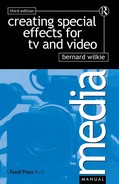Computerised Effects – 1
Although computer-generated stock effects can be employed during recording, computer input is usually reserved for post-production work.
Computer technology has reached a stage where images can be created to mimic real life; the simulation of shining gold or silver letters that turn and twist in the light, their shadows and reflections moving across apparently polished surfaces is a typical example.
Before the computer can create anything it must be given information. This can be input via electronically scanned drawings or photographs, or by the use of models and three-dimensional subjects transmitted from a video camera. Images can also be hand-drawn straight onto the screen via an electronic pen and palette.
The key factor is the software. Using stored information a designer needs only to plot a few points on the screen to create an outline (a ‘wire frame’) of the required object and use the program to fill in the details. At this stage the object can be given form, e.g. it can be turned from a flat rectangle into a cylinder by lighting it from a particular direction. The program automatically supplies the correct shadows and highlights which make it appear three dimensional.
Explosions
Computer-generated explosions can be tailored to suit the action and moved to any part of the scene. Small explosions can be enlarged and large ones reduced, while the proportion of debris, sparks and brilliance can all be varied. Electronically generated explosions are commonly used in science fiction (combat sequences in spaceships), but pyrotechnic explosions are employed where lingering smoke and practical destruction are required.
Morphing
This is the effect in which one thing apparently turns into another. Given a human face and a lion’s head, the computer can be programmed to metamorphose one into the other by a process of interpolation. Key areas such as the nose, mouth and eyes would be given defined parameters and the one face would then transform into the other. Unlike super-imposition, this creates a faultless transition.
Computerised effects – 1
1. Memorised effects can be used to modify other inputs. Here the stored image of corrugated paper is used to texture a stone building.
2. Flames (which far from being ‘just flames’ are highly complex structures) demonstrate the sort of problems which can confront computer animators.

